The Goddess of Love and Beauty

Venus Bathing, Roman, unknown sculptor after Praxiteles, A.D. 175–200. Marble and pigment, 38 1/4 in. (97.2 cm) high. The J. Paul Getty Museum, 72.AA.93
The essence of Aphrodite's power was her ability to provoke desire. Sexual allure was long an intrinsic aspect of Aphrodite, and erotic pleasures were referred to as ta Aphrodisia, "the business of Aphrodite." The goddess's body was not fully revealed in Greek art, however, until about 350 B.C., when a sensational cult statue in her temple at Knidos (in present-day Turkey), carved by the sculptor Praxiteles, represented her naked for the first time.
The head shown below was carved not long after the Aphrodite at Knidos, and its softly defined facial features capture qualities that were noted in Praxiteles' famous statue: dewy eyes, radiance, and winsomeness.
Aphrodite's Figure Types
Praxiteles' original statue does not survive, but its renown was great. Replicas such as the Roman example at right give a good idea of its appearance. The goddess lifts her clothing over a small water vessel with one hand and covers her genitals with the other, a gesture that may be understood as drawing attention to her sexual power.- AUDIO: Hear more about Aphrodite and how this sculpture reveals her power.
Update Required
To play the media you will need to either update your browser to a recent version or update your Flash plugin.
The head shown below was carved not long after the Aphrodite at Knidos, and its softly defined facial features capture qualities that were noted in Praxiteles' famous statue: dewy eyes, radiance, and winsomeness.
In the aftermath of Praxiteles' Aphrodite at Knidos, innumerable images of the goddess in varying degrees of undress were created throughout the ancient Mediterranean. Scholars have identified a number of recurring figure types—such as the crouching Aphrodite, with the goddess looking over her shoulder as she bends down to wash herself, or Aphrodite wringing out her hair.
The variety of media and scale used to depict Aphrodite not only testifies to her enduring importance, but also prompts us to consider her significance in diverse contexts—from civic statuary and private garden sculpture to votive offerings, grave gifts, and precious trinkets.
The variety of media and scale used to depict Aphrodite not only testifies to her enduring importance, but also prompts us to consider her significance in diverse contexts—from civic statuary and private garden sculpture to votive offerings, grave gifts, and precious trinkets.
Related Information
On The Iris
- Eros, the Naughty Superhero of Love
By David Saunders, curator of the installation at the Getty Villa


